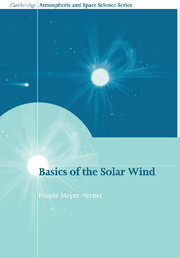Book contents
- Frontmatter
- Contents
- Preface
- 1 The wind from the Sun: an introduction
- 2 Tool kit for space plasma physics
- 3 Anatomy of the Sun
- 4 The outer solar atmosphere
- 5 How does the solar wind blow?
- 6 Structure and perturbations
- 7 Bodies in the wind: dust, asteroids, planets and comets
- 8 The solar wind in the Universe
- Appendix
- Index
3 - Anatomy of the Sun
Published online by Cambridge University Press: 22 October 2009
- Frontmatter
- Contents
- Preface
- 1 The wind from the Sun: an introduction
- 2 Tool kit for space plasma physics
- 3 Anatomy of the Sun
- 4 The outer solar atmosphere
- 5 How does the solar wind blow?
- 6 Structure and perturbations
- 7 Bodies in the wind: dust, asteroids, planets and comets
- 8 The solar wind in the Universe
- Appendix
- Index
Summary
‘Ήλιος γὰϱ οὑχ ὐπεϱβήσεται μέτ ϱα. εἰ δὲ μή, Ἐϱινύες μιν Δίκης ἐπίκου ϱοι ἐξεϱήσουσιν
Heraclitus of EphesusWhat makes the Sun behave as it does? How does it shine? What causes its magnetic activity? And finally, how is its atmosphere produced? We will address these questions in a simplified way, using fundamental physics and the tools of plasma physics introduced in Chapter 2. There are large gaps in our understanding, however. Whereas we understand reasonably well how the Sun shines, its magnetic activity is still not correctly understood. In the spirit of this book, I have put aside the non-essential points and tried to highlight the main physics; far more complete accounts at various levels may be found in and.
An (almost) ordinary star
The mass of the Sun is 2 X 1030 kg – a typical value for a normal star, that is an object which shines steadily for a fairly long time (by astronomical standards) by burning hydrogen; in the astronomer's jargon this is called a main-sequence star. The largest mass observed for a normal star is of the order of 102M⊙, while the lower limit is slightly below 10-1M⊙.
Less massive objects may shine at the beginning of their life, but they rapidly cool into obscurity. Those lighter objects include brown dwarfs and giant planets; brown dwarfs are now known to be very common objects, straddling the realms of planets and stars; in some sense they are aborted stars, while their physics and chemistry are very similar to those of giant planets.
- Type
- Chapter
- Information
- Basics of the Solar Wind , pp. 113 - 164Publisher: Cambridge University PressPrint publication year: 2007



